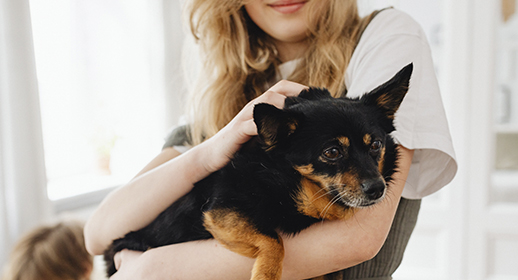- Home
- How to Know if Your Dog is Stressed


Photo by Karolina Grabowska on Unsplash
How to Know if Your Dog is Stressed
It can be hard to know if your furry friend is feeling stressed, as the signs of stress in dogs aren’t always obvious at first. So that you can support your pup, it’s important to be able to identify when your pooch isn’t quite feeling themself. By observing their body language and behaviour in stressful situations, you’ll know the triggers or signs of stress and anxiety to look out for in future.
Do dogs get stressed?
Dogs can experience stress from a wide range of triggers, such as being left alone for extended periods, loud noises, unfamiliar surroundings, or aggressive behaviour from other dogs. Although our furry companions can’t express their emotions verbally, they can show physical and behavioural signs of stress.
How to spot signs of stress in your dog
As dogs have different temperaments, they can respond to anxiety in a variety of ways, so the key is being able to differentiate their anxious behaviours from their usual demeanour. This said, there are some common indicators of stress you can watch for in your dog’s body language and behaviour.
Body Language
One of the best ways to spot stress in dogs is to watch their body language, as they’ll often tuck their tail, pant excessively, pace around, avoid eye contact, or even stare at you when stressed. They may also tremble or shake, especially if they’re feeling scared.
Behaviour
You may spot changes to your dog’s behaviour during stressful situations. For example, they may hide or avoid meeting new people, bark incessantly, become clingy, act aggressively, or display undesirable behaviours, like chewing on household items or obsessive licking.
How to prevent stress
Preventing stress in dogs is always better than trying to calm them down. Creating a comfortable environment or socialising your pup can help prevent stressful situations from arising and look after their mental wellbeing.
Stick to a routine
Dogs thrive on routine, as the predictability provides them with a sense of comfort. To create structure in your pup’s life, try to keep their feeding, exercise, and playtime as consistent as possible from day to day.
Provide a safe and comfortable environment
Making sure your dog has a safe space to retreat to when they need some downtime can do a lot when preventing stress. This could be a crate filled with their favourite toys and blanket, or a cosy bed tucked away from the hustle and bustle of your household.
Socialise your dog
Socialising your dog with people and other animals can build their confidence and help them feel more settled in unfamiliar situations. Though it’s best to start their socialisation when they’re a puppy, you can get them used to being around people and other pets later in life with a calm and gradual approach.
Give them regular exercise
Regular exercise isn’t only great for your dog’s physical health but also their mental wellbeing. In fact, a lack of activity can leave them feeling depressed or frustrated, so make sure you create time for walks and playtime. Most dogs need at least one to two walks a day to keep them well exercised and mentally stimulated by all the fun sights and smells.
How to calm down your stressed dog
If you notice signs of stress in your dog, there are a few things you can do to help them relax, including timeouts away from noise and activity, and products like essential oils and calming treats.
Allow them some time away
If being around people, other animals, or lots of noise is the cause of your pup’s stress, a change of scenery away from the action can help calm them down. This could be their crate or bed if you’re at home, or a quick walk or timeout in a quiet space.
Use aromatherapy
Essential oils like lavender and chamomile can help to relax dogs. You can use these in a room diffuser, a calming pet diffuser, or as a spray that you can spritz around the room or onto their bed. Remember dogs have a much stronger sense of smell than us, so a little will go a long way.
Try calming treats or supplements
There are a variety of treats and supplements on the market that are designed to help calm your pooch down if they’re feeling stressed.
Play calming music
Playing music can be a useful technique to help a dog relax and block out external sounds when they’re left alone. Choose something soft and slow, such as classical or piano music, which will hopefully have a soothing effect on them. Keep the volume low and observe your dog’s body language to see if they relax. Be sure to also give them breaks from any music.
Every dog is different, so it’s important to learn the signs that your pup is feeling stressed and how you can help them relax. If you’ve tried a few things to relieve your dog’s anxiety without success, talk to your vet to develop a plan that best suits your dog's specific needs. For more tips on caring for your dog, check out our blog.
© 2023 Mars or Affiliates.
Buy online
Click to buy from any of the retailers below





